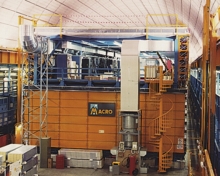The MACRO Experiment: Monopole Astrophysics and Cosmic Ray Observatory
Ed Kearns, James Stone, Lawrence Sulak

The deep underground MACRO detector operated at the Laboratori Nazionali del Gran Sasso in Abruzzo, Italy from 1990 to 2000. MACRO had a geometrical acceptance of 10,000 square meters at an average depth of 3.8 kilometers of water equivalent under the mountainous overburden of the Gran Sasso d'Italia. The MACRO detector was used to research several topics. The specialty of MACRO was the search for magnetic monopoles: particles with bare north or south magnetic charge. These particles are a natural consequence of Grand Unified Theories, which also predict that the monopole will be very massive, perhaps 10 to the power 16 GeV. Such particles can only be produced by the intense energies available during the big bang. MACRO operated like a giant Time-Of-Flight counter to detect the unique signature of a slow moving but penetrating massive particle. It was equipped with tanks of liquid scintillator, planes of streamer tubes and plates of track etch material in the hopes of recording a convincing signature from a single candidate event. MACRO's high-resolution tracking and timing were also used to perform high statistics measurements of cosmic ray muons; in particular, the scintillator timing was used to distinguish upward going muons produced by neutrino interactions in the rock. This was an opportunity to investigate the possible flavor oscillation of massive neutrinos as suggested by the atmospheric neutrino puzzle, and MACRO was the first experiment to independently confirm the atmospheric neutrino oscillation signal seen by Super-Kamiokande.
 Physics (Internal)
Physics (Internal)